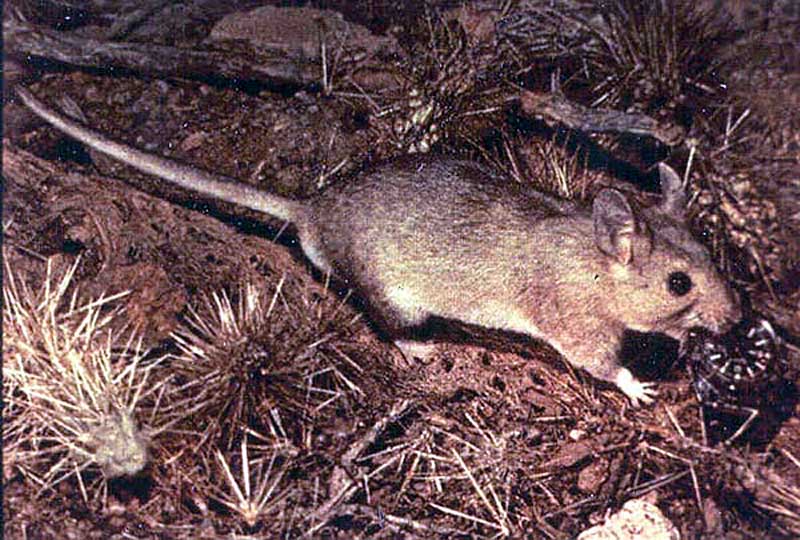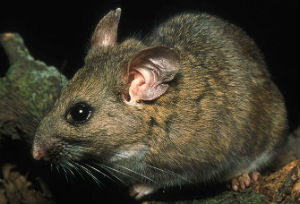Interactions
The Dusky-footed Wood rat falls under
many relationship categories--competitive, commensalism,
parasitic, and predatory. Its interactions with other species
make up it’s lifestyle—where it gathers food, nests, and roams.
Some predators of this animal involve
owls, skunks,hawks,
coyotes,
wolves, and wildcats (Bonadio, 2000; National Wildlife
Federation, 2012). Being a nocturnal animal, these rodents eat
fungi and plants during the night, of which include bark,
greens, seeds, and fruits. It is competition to get these foods,
considering other herbivores are seeking out the same foods
(National Wildlife Federation, 2012). It helps for them to be
nocturnal, that way they don’t have any face-to-face
conflictions over food.
As for other relationships this
animal has, the parasitic relationship consists of the wood rat
carrying parasites like fleas, ticks, and mites. If a wood rat
family decides to relocate, many other small animals use the
wood rat’s means of shelter. Their homes make good shelters for
reptiles such as
snakes, creating a commensal relationship
between the two (Bonadio, 2000).
The dusky footed wood rat is an
herbivore who collects its food from vegetation in its surrounding habitat; for example: plants,
fruits, and
nuts.
Considering this species is mostly nocturnal, their small feet
help them to scurry and get food quietly. The food gathered is
not only used for nutrients, but water as well. Based on the
season, plants with high water content may be scarce. The wood
rat is known for storing extra food in its home and at night,
consume the majority of it (Bonadio, 2000). In one observation,
the wood rat studied collected 132 pieces of fresh cuttings
throughout the night. A total consumed in this one night was
about 44 grams, which is normal for them (Bonadio, 2000).
surrounding habitat; for example: plants,
fruits, and
nuts.
Considering this species is mostly nocturnal, their small feet
help them to scurry and get food quietly. The food gathered is
not only used for nutrients, but water as well. Based on the
season, plants with high water content may be scarce. The wood
rat is known for storing extra food in its home and at night,
consume the majority of it (Bonadio, 2000). In one observation,
the wood rat studied collected 132 pieces of fresh cuttings
throughout the night. A total consumed in this one night was
about 44 grams, which is normal for them (Bonadio, 2000).
As for the food web, the wood rat
fits at the end. Its only “prey” would be plants, which are
basically defenseless. On the other hand, with its small figure,
it is easily preyed upon by many other animals above it. To find
more about its part in the food chain, see the
Form and Function page.
For means of survival, the way this
organism travels is key. If its trail is close to the surface
and clear of impediment, the wood rat has a successful trip out
to gather food. Due to its small feet, it can scurry fast
(Innes, et al, 2007). If there are several forms of brush and
leaves on the ground, the animal walks slowly by lifting one
small leg at a time. Running across these leaves could cause a
lot of noise, making them more susceptible to attracting
predators. If there are long branches, it prefers to scamper
across them instead of around them. While running, the tail is
pointed straight out parallel to the ground, in order to
eliminate as much noise as possible (Bonadio, 2000).
As for its interactions with other
species, the species usually are tolerant of each other between
houses. In a normal setting, the dusky-footed wood rat is quiet
but still attentive, with most of its weight bearing on its hind
legs. However, when irritated, the ears are pulled back tight.
Such occurrences could happen when males are fighting. To
signify a fight, both animals pound their tails against the
ground while opening and closing their mouths. Normally, one
male will initiate the argument by charging and biting its
opponent (Bonadio, 2000).
 Because the males travel to different houses to find a mate,
interactions within houses happen mostly between females. The
male comes into play once it has chosen a mate and permanently
lives in the home with the female wood rat. To learn more about
mating and reproduction, visit the
Reproduction page. These wood rats have to have spectacular
sanitation routines, where the most wastes are kept outside of
the home. Because it is highly unlikely that all waste is kept
out of the home, the waste that does collect is placed in areas
that are not hindering their daily living activities.
Because the males travel to different houses to find a mate,
interactions within houses happen mostly between females. The
male comes into play once it has chosen a mate and permanently
lives in the home with the female wood rat. To learn more about
mating and reproduction, visit the
Reproduction page. These wood rats have to have spectacular
sanitation routines, where the most wastes are kept outside of
the home. Because it is highly unlikely that all waste is kept
out of the home, the waste that does collect is placed in areas
that are not hindering their daily living activities.
The interaction between humans and
the dusky footed wood rat is actually a positive relationship.
Many of these animals are found at the base of rat houses. With
eating and drinking comes feces, which humans have found to be a
very good fertilizer.
The wood rat is mostly found in
California, where agriculture is predominant. This fertilizer is
in abundance and used by farmers to fertilize their fields to
promote growth of their crops (Bonadio, 2000).
Home
Facts
Gabriella Tuminello and Emma Conway of the University of
Wisconsin - La Crosse. Bio 203 - Spring 2014